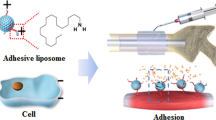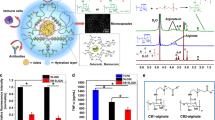Abstract
Controlled release from biodegradable polymers is a novel approach to replace daily painful injections of protein drugs. A major obstacle to development of these polymers is the need to retain the structure and biological activity of encapsulated proteins during months of incubation under physiological conditions. We encapsulated bovine serum albumin (BSA) in injectable poly(DL-lactide- co-glycolide) (PLGA) 50/50 cylindrical implants and determined the mechanism of BSA instability. Simulations of the polymer microclimate revealed that moisture and acidic pH (<3) triggered unfolding of encapsulated BSA, resulting in peptide bond hydrolysis and noncovalent aggregation. To neutralize the acids liberated by the biodegradable lactic/glycolic acid-based polyester, we coincorporated into the polymer an antacid, Mg(OH)2, which increased microclimate pH and prevented BSA structural losses and aggregation for over one month. We successfully applied this stabilization approach in both cylinder- and microsphere-injectable configurations and for delivery of angiogenic basic fibroblast growth factor and bone-regenerating bone morphogenetic protein-2.
This is a preview of subscription content, access via your institution
Access options
Subscribe to this journal
Receive 12 print issues and online access
$209.00 per year
only $17.42 per issue
Buy this article
- Purchase on Springer Link
- Instant access to full article PDF
Prices may be subject to local taxes which are calculated during checkout



Similar content being viewed by others
References
Langer, R. & Folkman, J. Polymers for the sustained release of proteins and other macromolecules. Nature 263, 797–800 (1976).
Struck, M.M. Biopharmaceutical R&D success rates and development times. A new analysis provides benchmarks for the future. Bio/Technology 12, 674–677 (1994).
Talmadge, J.E. The pharmaceutics and delivery of therapeutic polypeptides and proteins. Adv. Drug Delivery. Rev. 10, 247–299 (1993).
Ogawa, Y., Okada, H., Heya, T. & Shimamota T. Controlled release of LHRH agonist, leuprolide acetate, from microcapsules: serum drug level profiles and pharmacological effects in animals. J. Pharm. Pharmcol. 41, 439–444 ( 1989).
Okada, H., Doken, Y., Ogawa, Y. & Toguchi, H. Preparation of three-month depot injectable microspheres of leuprorelin acetate using biodegradable polymers. Pharm. Res. 11, 1143 (1994).
Dutta, A.S., Furr, B.J.A. & Hutchinson, F.G. Discovery and development of goserelin (Zoladex). Pharm. Med. 7, 9–28 ( 1993).
Schwendeman, S.P., Cardamone, M., Klibanov., A. & Langer, R. in Microparticulate systems for the delivery of proteins and vaccines (eds Cohen, S. & Bernstein, H.), 1–49 (Marcel Dekker, New York; 1996).
Schwendeman, S.P., Costantino, H.R., Gupta, R.K. & Langer, R. in Controlled drug delivery. (ed. Park, K.), 229– 267 (American Chemical Society, Washington, D.C; 1997).
Johnson, O.L. et al. A month-long effect from a single injection of microencapsulated human growth hormone. Nat. Med. 2, 795– 799 (1996).
Cleland, J.L. & Jones, A.J.S. Stable formulations of recombinant human growth hormone and interferon-gamma for microencapsulation in biodegradable microspheres. Pharm. Res. 13, 1464– 1475 (1996).
Schwendeman, S.P., Tobio, M., Joworowicz, M., Alonso, M.J. & Langer, R. New strategies for the microencapsulation of tetanus vaccine. J. Microencapsulation 15, 299–318 (1998).
Putney, S.D. & Burke, P.A. Improving protein therapeutics with sustained-release formulations. Nat. Biotechnol. 16 , 153–157 (1998).
Costantino, H.R., Langer, R. & Klibanov, A.M. Solid-phase aggregation of proteins under pharmaceutically relevant conditions. J. Pharm. Sci. 83, 1662–1669 (1994).
Herrlinger, M. Ph.D. In vitro polymerabbau und wirksttofffreigabe von poly-DL-laktidformlingen Thesis, Univ. Heidelberg, Germany (1994).
Shenderova, A., Burke, T. & Schwendeman, S.P. The acidic microclimate in poly(lactide-co-glycolide) microspheres stabilizes camptothecins. Pharm. Res. 16, 241–248 (1999).
Brunner, A., Mäder, K. & Göpferich, A. pH and osmotic pressure inside biodegradable microspheres during erosion. Pharm. Res. 16, 847– 853 (1999).
Mader, K., Bittner, B., Li, Y., Wohlauf, W. & Kissel, T. Monitoring microviscosity and microacidity of the albumin microenvironment inside degrading microparticles from poly(lactide-co-glycolide) (PLG) or ABA-triblock polymers containing hydrophobic poly(lactide-co-glycolide) A blocks and hydrophilic poly(ethyleneoxide) B blocks. Pharm. Res. 15, 787–793 ( 1998).
Fu, K., Pack, D.W., Laverdiere, A., Son, S. & Langer, R. Visualization of pH in degrading polymer microspheres. Proceedings 25th International Symposium on Controlled Resealse of Bioactive Materials 25, 150 –151 (1998).
Mader, K., Gallez, B., Liu, K.J. & Swartz, H.M. Non-invasive in vivo characterization of release processes in biodegradable polymers by low-frequency electron paramagnetic resonance spectroscopy. Biomaterials 17, 457–461 ( 1996).
Peters, T. Jr. Serum albumin. Adv. Protein Chem. 37, 161 –245 (1985).
Manning, M.C., Patella, L. & Borchardt, R.T. Stability of protein pharmaceuticals. Pharm. Res. 6, 903–917 ( 1989).
Heller, J. Development of poly(ortho esters): a historical overview. Biomaterials 11, 659–665 ( 1990).
Li, S.M., Garreau, H. & Vert, M. Structure-property relationships in the case of the degradation of massive poly(a-hydroxy acids) in aqueous media. Part 3. Influence of the morphology of poly(L-lactic acid). J. Mater. Sci. 1 , 123–130 (1990).
Hutchinson, F.G. & Furr, B.J.A. Biodegradable polymer systems for the sustained release of polypeptides. J. Controlled Release 13, 279–294 ( 1990).
Wang, Y.J. et al. in Formulation, characterization, and stability of protein drugs (eds Pearlman, R. & Wang, Y.J.) 141–180 (Plenum Press, New York; 1996).
Edelman, E.R., Nugent, M.A. & Karnovsky, M.J. Perivascular and intravenous administration of basic fibroblast growth factor: vascular and solid organ deposition. Proc. Natl. Acad. Sci. USA 90, 1513– 1517 (1993).
Berscht, P.C., Nies, B., Liebendorfer, A. & Kreuter, J. Incorporation of basic fibroblast growth factor into methylpyrrolidinone chitosan fleeces and determination of the in vitro release characteristics. Biomaterials 15, 593–600 (1994).
Fukunaga, K. et al. Aluminium beta-cyclodextrin sulphate a stabilizer and sustained-release carrier for basic fibroblast growth factor. J. Pharm. Pharmacol. 46, 168–171 ( 1994).
Edelman, E.R., Mathiowitz, E., Langer, R. & Klagsbrun, M. Controlled and modulated release of basic fibroblast growth factor. Biomaterials 12, 619–626 (1991).
Davies, M.J. et al. In vitro assessment of the biological activity of basic fibroblast growth factor released from various polymers and biomatrices. Journal of Biomaterial Applications 12, 31– 56 (1997).
Wang, E.A. et al. Recombinant human bone morphogenetic protein induces bone formation. Proc. Natl. Acad. Sci. USA 87, 2220– 2224 (1990).
Welch, R.D. et al. Effect of recombinant human bone morphogenetic protein-2 on fracture healing in a goat tibial fracture model. J. Bone Miner. Res. 13, 1483–1490 (1998).
Mayer, M., Hollinger, J., Ron, E. & Wozney, J. Maxillary alveolar cleft repair in dogs using recombinant human bone morphogenetic protein-2 and a polymer carrier. Plast. Reconstr. Surg. 98, 247–259 (1996).
Kenley, R.A. et al. Biotechnology and bone graft substitutes. Pharm. Res. 10, 1393–1401 ( 1993).
Gospodarowicz, D. & Cheng, J. Heparin protects basic and acidic FGF from inactivation. J. Cell. Physiol. 128, 475–484 (1986).
Sommer, A. & Rifkin, D.B. Interaction of heparin with human basic fibroblast growth factor: protection of the angiogenic protein from proteolytic degradation by a glycosaminoglycan. J. Cell. Physiol. 138, 215–220 ( 1989).
Sullivan, R. & Klagsbrun, M. Purification and assay of intact human basic fibroblast growth factor using heparin-sepharose chromatography . J. Tiss. Culture Methods 10, 125– 132 (1986).
Crotts, G., Sah, H. & Park, T.G. Adsorption determines in-vitro protein release rate from biodegradable microspheres: quantitative analysis of surface area during degradation. J. Controlled Release. 47, 101–111 ( 1997).
Zhang, X., Wyss, U.P, Amsden, B. & Goosen, M.F.A. Controlled release of albumin from biodegradable poly(DL-lactide) cylinders. J. Controlled Release 25, 61–69 (1993).
Cohen, S., Yoshioka, T., Lucarelli, M., Hwang, L.H. & Langer, R. Controlled delivery systems for proteins based on poly(lactic/glycolic acid) microspheres. Pharm. Res. 8, 713–720 (1991).
Schwendeman, S.P. et al. Stabilization of tetanus and diphtheria toxoids against moisture-induced aggregation. Proc. Natl. Acad. Sci. USA 92, 11234–11238 (1995).
Liu, W.R., Langer, R. & Klibanov, A.M. Moisture-induced aggregation of lyophilized proteins in the solid state. Biotechnol. Bioeng. 37, 177–184 (1991).
Shenderova, A., Burke, T.G. & Schwendeman, S.P. Stabilization of 10-hydroxycamptothecin in poly(lactide-co-glycolide) microsphere delivery vehicles. Pharm. Res. 14, 1406–1413 (1997).
Watanabe, H. et al. A sensitive enzyme immunoassay for human basic fibroblast growth factor. Biochem. Biophys. Res. Commun. 175, 229–235 (1991).
Gabra, N., Khiat, A. & Calabresi, P. Detection of elevated basic fibroblast growth factor during early hours of in vitro angiogenesis using a fast ELISA immunoassay . Biochem. Biophys. Res. Commun. 205, 1423–1430 (1994).
Acknowledgements
We thank Dr. John Wang of Synzyme Technologies (Irvine, CA) for his helpful suggestions. We are very grateful to Prof. Mark Coggeshall, from the Department of Microbiology of the Ohio State University for his help in the bFGF bioassay experiment. We thank Dr. Hanne Bentz from Orthogene and Prof. Jeffrey Hubbell from the Swiss Federal Technology Institute for their aid in the BMP-2 studies. We also thank Professor Gary Means from the Department of Biochemistry, and Dr. Jichao Kang of the College of Pharmacy at the Ohio State University for their helpful discussions and technical assistance, respectively. This work was supported by NIH DE 12183 and a PhRMA grant to S.P.S.
Author information
Authors and Affiliations
Corresponding author
Rights and permissions
About this article
Cite this article
Zhu, G., Mallery, S. & Schwendeman, S. Stabilization of proteins encapsulated in injectable poly (lactide- co-glycolide). Nat Biotechnol 18, 52–57 (2000). https://doi.org/10.1038/71916
Received:
Accepted:
Issue Date:
DOI: https://doi.org/10.1038/71916
This article is cited by
-
Aqueous remote loading of model cationic peptides in uncapped poly(lactide-co-glycolide) microspheres for long-term controlled release
Drug Delivery and Translational Research (2024)
-
In vitro degradation and erosion behavior of commercial PLGAs used for controlled drug delivery
Drug Delivery and Translational Research (2023)
-
Basic Salt Additives Modulate the Acidic Microenvironment Around In Situ Forming Implants
Annals of Biomedical Engineering (2023)
-
Efficient aqueous remote loading of peptides in poly(lactic-co-glycolic acid)
Nature Communications (2022)
-
Release of human growth hormone from an in-situ implant modulated by poly(ethylene glycol) dimethyl ether and tris(hydroxymethyl) aminomethane
Iranian Polymer Journal (2020)



